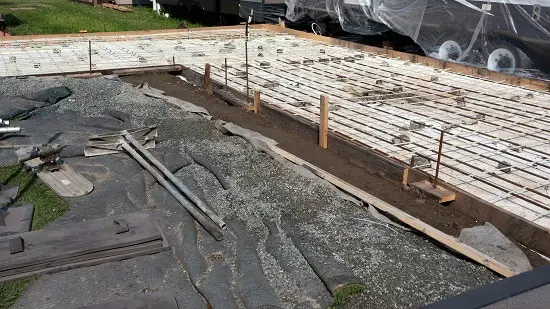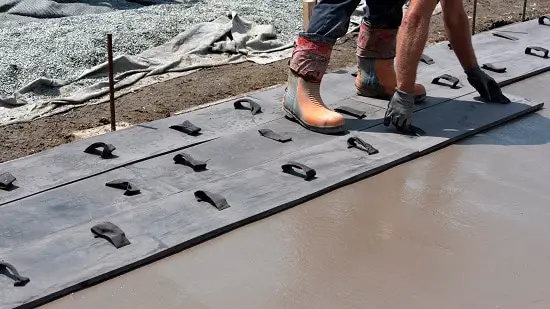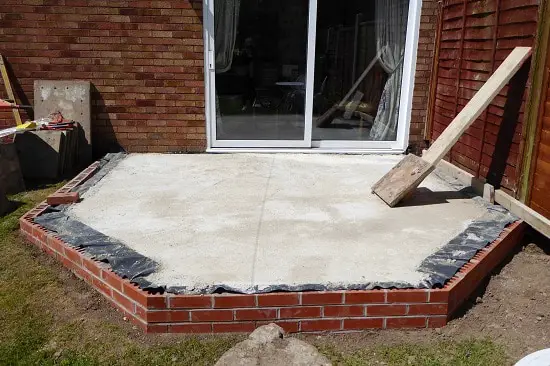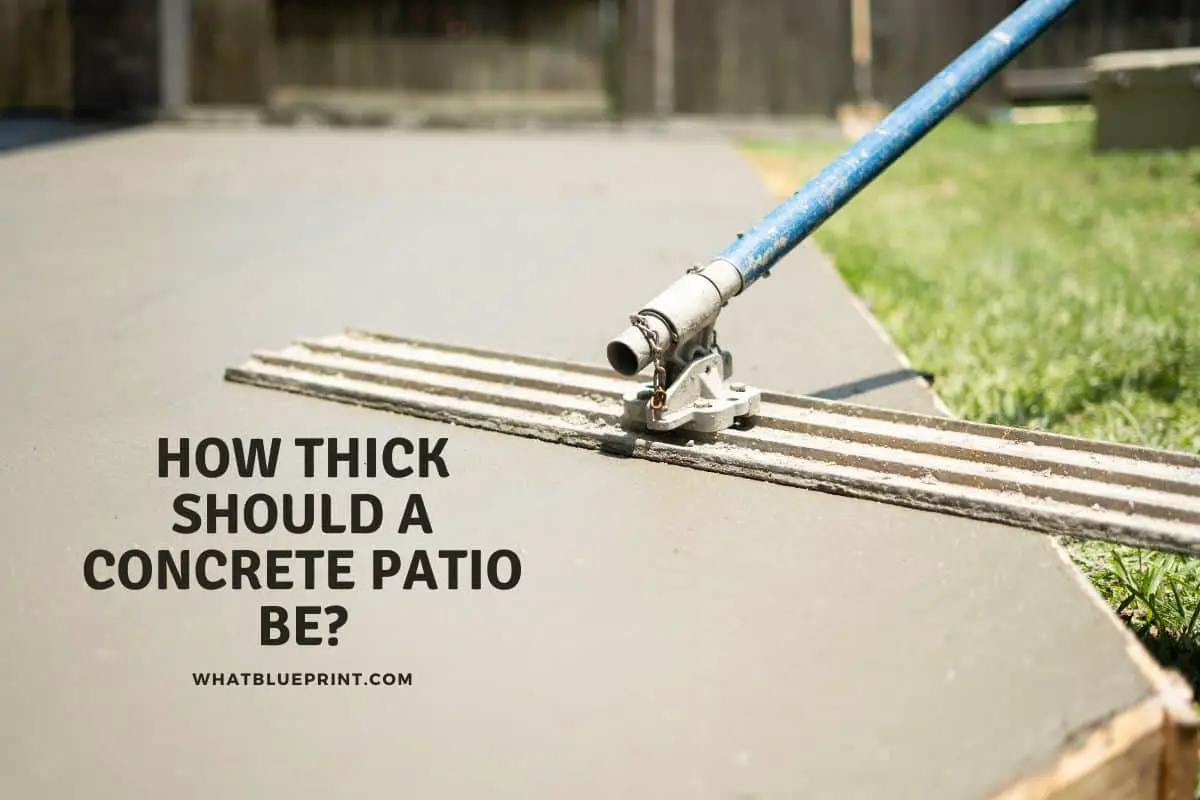How Thick Should A Concrete Patio Be?
You need to consider several things when creating your patio or having one built for you. One of the biggest head-scratchers that people experience is when they need to decide on the thickness of the concrete patio.
The code for the United States says that a concrete patio must be four inches thick at a minimum; six to eight inches is recommended if you have heavy furniture. When you have hot tubs, gazebos, and other permanent structures, it is recommended to have eight to ten inches of concrete.
Many people are staggered to learn that a concrete patio’s thickness matters and that even the layout can affect what you can use. One of the most central things to remember is that the concrete under the patio heavily influences what you can and cannot do with your patio later, especially if large items like hot tubs and pools are being considered.
How Thick Should An Outside Concrete Patio Slab Be?
While the minimum thickness, as set out by the codes in most countries, is four inches, there are several things that you will have to consider. The thickness of a concrete patio will decide how heavy everything on top of the patio will be.
Four inches gives the concrete enough strength to handle most regular foot traffic, drastically changing when you build larger patios. A wider and longer than five to six feet patio will need thicker concrete to support the weight of the patio itself.
We recommend that you plan accordingly, ensuring that the patio can withstand the combined weight of everything on top of it at any time. Many concrete patios are specifically made with thick reinforced concrete to handle more weight than most house floors.
Can You Color Or Texture A Concrete Patio Slab?
When pouring the concrete patio slabs, you can use concrete dyes to color the concrete during mixing. This completely changes the color of the concrete and allows you to customize the patio without adding any extra layers on top.
It should be known that the type of dye you are using will also affect the patio strength, with many engineers recommending you use smaller slab sizes. This makes the concrete stronger and more flexible when the earth moves and changes beneath the concrete slabs.
We recommend that you read the instructions on the dye before adding it to the concrete mixtures, as many are only meant to be added once the concrete is poured. If unsure, you can use epoxy coatings to color the concrete patio once it has dried instead of using a dye.

How To Decide On The Thickness Of A Concrete Patio?
While planning your patio, you will need to specify the thickness of the concrete for your patio, which means you will need to know what to consider. We usually consider five things before determining the thickness of the concrete, allowing us to have a patio that can handle any extra weight.
Each must be considered, with many people forgetting these, causing their concrete to crack and warp as the patio ages. Once the concrete has cracked owing to too much weight on the patio, it can take several weeks to fix everything as it needs to be strengthened properly.
1. The Size Of The Patio
The actual size of the patio will determine how thick the concrete slab will need to be, with large patios naturally requiring thicker slabs. Patios over 10 feet in any dimension require different types of concrete slabs than a normal concrete patio. If you are looking at costing this up before you start then you can check out this article on the cheapest options for patios.
As the patio’s size increases, the concrete slab’s weight increases dramatically, so you must section it off properly. You will often need to pour a foundation first, connecting the concrete blocks to these foundations instead of just laying on top of gravel and pillars.
The Ground Under And Around The Patio
Another big deciding factor in your concrete thickness is the type of ground that you are building on, with dirt requiring thicker concrete with deeper foundations. If you don’t consider this, you may find that your entire patio floats and washes away in the first big storms that sweep through your town.
Suppose you live in an area with soil that is more gravel and rocky; you will need to ensure that the concrete is thick but also poured into sections. Allowing the patio to shift and change as the rocks and dirt move, preventing your patio from being damaged or cracking as the earth moves.
What The Patio Is Used For
If you use your patio for simple barbecues and not much else, you can use a thinner concrete slab overall. However, if you are building a hot tub, small pool, furniture, and a gazebo, the concrete needs to be thick enough to handle the weight these items will add.
If you have a patio that will only be a concrete slab for people to use now and then, you will only need a thinner piece of concrete. However, if you plan to build a full outdoor living space where you are living and relaxing most of the time, you need something thick enough not to crack and to last you a lifetime.
The Furniture On Top Of The Patio
Few people outside the engineering world always realize that furniture can become extremely heavy with a few added items. You will need to consider the type and weight of the furniture you will use on the concrete patio.
Even wicker furniture can add several hundred pounds when you have full sets on your patio with a few small tables next to them. We recommend that you plan out the furniture you will use and try to find out how much each will weigh when used together.
Should A Concrete Patio Be Solid Throughout?
No, when using concrete, you must ensure gaps and spaces to prevent cracks from spreading across the slab. This is why you will always see large concrete pieces poured in sections, allowing the concrete to settle and shift without damaging the entirety of the slab.
Further, when working with larger patios, the foundation will support the concrete in specific locations to create the best support structure. We recommend having ground surveyors and a few other engineers help you design this, as you may also need to use reinforced concrete.
Multiple people have made the mistake of pouring one massive slab of solid concrete only to have it crack as soon as everything is dried out. The best patio concrete slabs have layers, are not completely solid, and have everything needed to ensure they can flex when needed.

Why Should Concrete Patios Be In Sections?
We have mentioned that concrete cracks multiple times and that the patio concrete will need to be in sections. But understanding why this is needed will prevent you from ignoring the reasons behind it, and you can end up with a set of patios that cannot work properly.
There are three reasons you need to pour concrete slabs in sections; these reasons are true for reinforced concrete or just normal concrete slabs. One of the worst effects that can happen to any concrete patio is when cracks start to appear, and nothing on it is even.
Cracking
Whether we want it to or not, concrete always cracks, usually with microcracks that are not visible and can never become a problem. However, if you have a large concrete slab, these micro-cracks can form together to cause much larger cracks that break the entire slab in half.
When the concrete is poured into specific slabs, the cracks that naturally form cannot spread to the other slabs. Further, smaller slabs are much less likely to crack and can drastically increase the maximum weight of the concrete patio.
Strength
By having multiple concrete slabs for your patio, you will also increase the strength of the patio. The patio can spread the weight much more evenly without the concrete bending or breaking as the concrete is put under pressure that it can’t handle.
Many people have mistakenly assumed that all that is needed is to make the concrete thicker to handle the weight. However, this can backfire as thicker concrete not separated into slabs can fail faster as the concrete succumbs to its weight.
Flexibility
Concrete is one of the hardest materials you will use when building your patio, which means that it is also susceptible to any flexing time. Because concrete does not handle flexing well or when something pulls on it, the concrete can easily crack or even crumble without notice.
Having the concrete reinforced and then poured into slabs that are not directly connected increases the sheer strength of the slab. This means that the patio won’t have cracks forming over time and that if something goes wrong, you can replace or reinforce the damaged slab.
Why Should Concrete Patios Be Thick?
Concrete is a unique building material that behaves oddly when put under certain types of pressure, which means that you need to consider several things when building with it. One of the strange things about concrete is that it can handle compression better than flexing or pulling.
When you build a concrete patio, you need to have it thicker because the main force that will push on the concrete is compression strength from above. This is why your concrete patio needs to be thick, allowing the concrete to be compressed down instead of pulled apart.
You need to reinforce the concrete with rebar to ensure it does not succumb to pulling pressure. The rebar helps the concrete stay intact even when forces push against it from the inside out or when the ground under the concrete flexes.

Conclusion
Your concrete patio needs to be thick enough to handle the weight of everything on top of it and not be damaged by the ground moving. Regulations in the US require at least four inches, but we recommend having your concrete patio be at least eight to ten to ensure it does not crack.
Whatever you do, please don’t pour your concrete slab without preparing the ground first!
References
- How Thick Should Concrete Be For A Patio? – Home Decor Bliss
- How Thick Should a Concrete Slab be? – The Constructor
- How Thick Should A Concrete Patio Be? (yardandgardenguru.com)
- Patio Slab Thickness Tips – Is a Thicker Concrete Slab Better? – YouTube
- Understand the Differences Between Concrete Dyes, Stains, and Pigments | For Construction Pros







